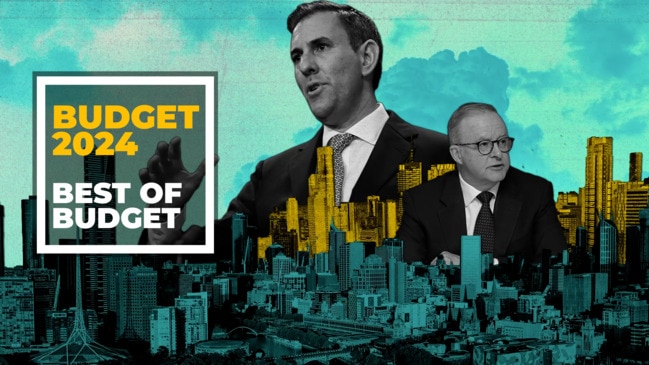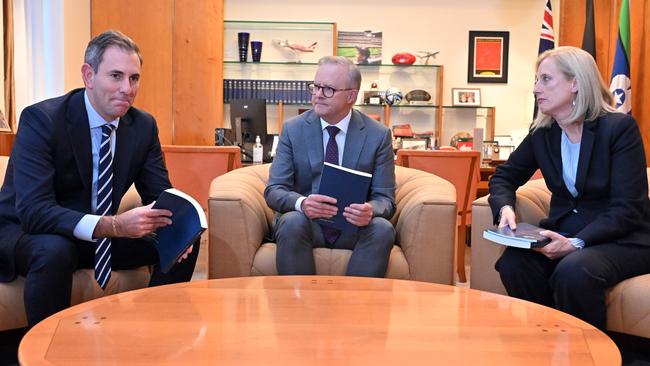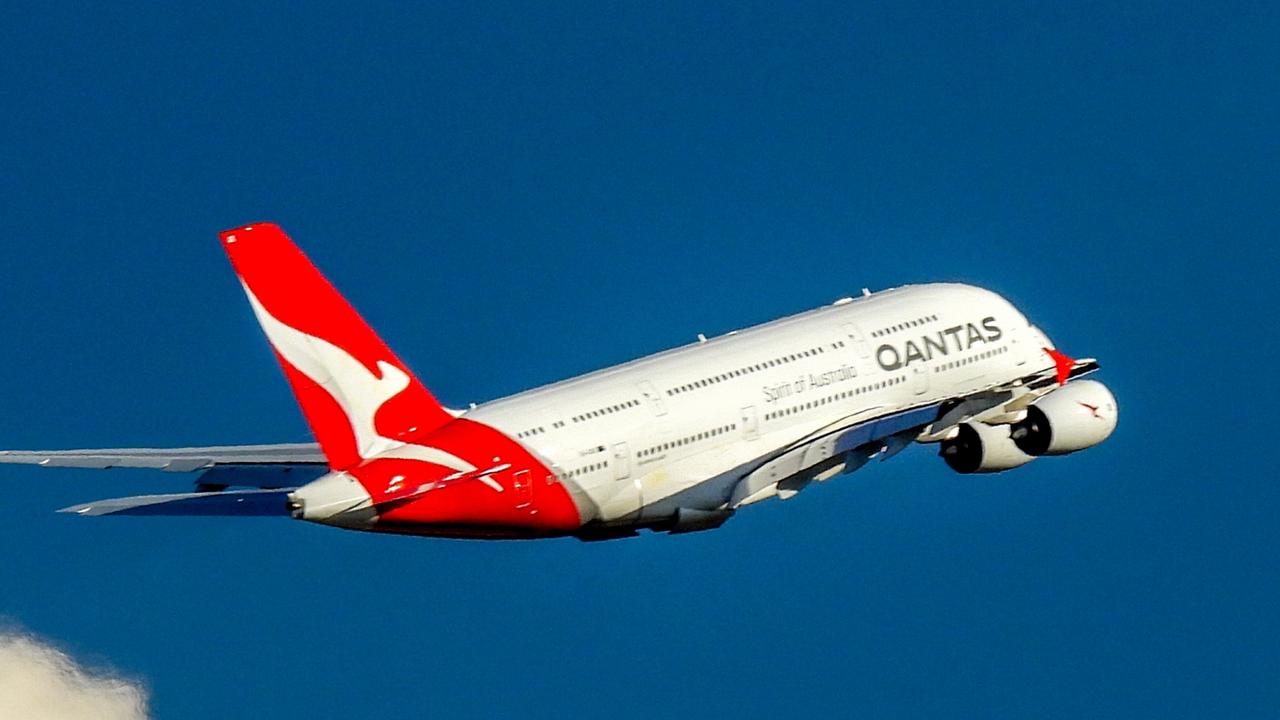Budget 2024: Jim Chalmers bets it all on inflation miracle
This budget simply doesn’t do any work to take inflation out of the economy. The pain will be felt by all Australians.

Business
Don't miss out on the headlines from Business. Followed categories will be added to My News.
Inflation has gone from the greatest challenge of our time to an afterthought in Jim Chalmers’ big spending, nation building, and energy-busting budget.
However, it is the Treasurer’s credibility that is on the line with the heroic assumptions that inflation can be tamed in the coming 12 months, bringing the price-bending scourge back inside the nation’s preferred range.
This outlook puts the Treasurer on a collision course with Reserve Bank governor Michele Bullock, who just last week said the inflation fight was far from over and warned that hiking the cash rate once again remained a live option.
But Chalmers has become Australia’s very own inflation whisperer, holding firm against the trend both here and around the world where the last mile of rising prices has become difficult and has even pushed up in some parts.

The Treasurer argues he is helping by limiting the spending growth to an average of 1.4 per cent a year and he is banking most of this year’s budget windfall that is curbing inflation. Even with nearly $8bn slated to be spent on broad-based cost of living relief across energy savings and rent assistance, and billions more in housing and building programs and the looming income tax cuts from July, Chalmers still anticipates inflation will get back to below target range by the end of this year. This is much earlier than what he was tipping just six months ago.
Instead of higher for longer, inflation “is expected to be lower, sooner”, Chalmers counters.
Even if you take his comments at face value, the budget simply doesn’t do enough – if any work – to take inflation out of the economy and this burden will be felt by all Australians.
Treasury’s numbers have inflation sitting at 2.75 per cent for each of the next two years meaning it will be comfortably inside the 2-3 per cent target band on its estimates.
Bullock’s RBA last week had inflation at 3.2 per cent next year and 2.8 per cent the year later. Many market economists were tipping early 2005 for a possible rate cut – the first in the current cycle. It is likely these estimates of rate cuts will be quietly pushed deeper into next year.
Deficit cliff
Nor does Chalmers do anything to confront the looming deficit cliff as cost-of-living programs and a pullback in commodity prices play havoc on the budget bottom line in coming years.
To underscore the dramatic shift in position, this financial year’s budget surplus of $9.3bn falls away to a deficit of $28.3bn next year, or spending of equivalent of 1 per cent of GDP. That’s a near $40bn collapse. A year later it deepens to nearly $43bn, or 1.5 per cent of GDP as payments for tax cuts and health funding bite.
It is likely the RBA will need to update its modelling to take into account the billions of extra spending.
Then it needs to add in big spending state governments from NSW, Victoria and Queensland with their own cost of living relief programs and infrastructure builds. Combined with Canberra’s own spending this could deliver a fiscal stimulus of around 2 per cent of GDP this coming year, according to UBS numbers.
Wesfarmers chief executive Rob Scott says we need to be mindful of the underlying drivers of cost inflation in the Australian economy: “We are seeing rents wage costs, energy costs continue to go up quite strongly. And, you know, we so we need to be mindful of the policy settings that can contribute to those.”

Treasury forecasts economic growth is set to pick up to 2 per cent by next year, shifting higher to Australia’s longer run average growth rate of 2.5 per cent by 2026. A pick-up in consumer spending from higher wages growth, employment growth and tax cuts should underpin the recovery.
The mood of consumers remains the biggest risk to this outlook, indeed another interest rate hike could derail the recovery in real disposable incomes. At the same time debt heavy households nervous about the outlook may opt to direct the spare cash into savings.
Treasury too has raised doubts over China’s “about 5 per cent” economic target for the coming year, forecasting Australia’s big trading partner will deliver growth of 4.75 per cent this calendar year, slowing to 4.25 per cent next year. Treasury has kept its conservative spot iron ore forecast of around $US60 a tonne, nearly half of what it currently fetches. Global growth is pitched at a robust 3.25 per cent for each of the next two years.
Business conditions
The latest Chalmers budget comes with a backdrop of business holding its own. Balance sheets are relatively sound, but the peak in profits has passed as interest rates and higher costs bite. Big business has so far resisted cutting jobs on the expected pick-up, although the retail sector is starting to feel the pinch as consumer spending pulls back. Australia’s big banks have reported unusually strong demand for business loans, which is a good indicator of expected business investment.
The big banks have just handed down their latest half-year results and while consumer and mortgage lending is slowing the uptick in lending losses is yet to arrive. They point to high levels of employment as buffering the worst of the interest rate hikes.
The National Australia Bank business conditions index released this week has eased from recent highs to the long-run average, while the prospect of higher-for-longer interest rates has started to eat away at business confidence. Employment intentions have pulled back, but remain in positive territory.
Business investment has withstood the global and domestic pressures, growing by a strong 8.3 per cent last year. The upswing in business investment is expected to continue through to financial 2026 and, if realised, will be the longest sustained increase in business investment since the mining boom.
Treasury expects investment to remain robust, although pulling back from elevated levels as spending on machinery and equipment eases. It is now tipping business investment growth at 1 per cent in financial 2025 and 2 per cent a year later. Non-mining investment is expected to be the main driver of growth in business investment over coming years.
Going green
The Chalmers budget provides Australia’s response to the America’s Inflation Reduction Act that has long kickstarted the global nuclear arms race in renewables spending in the race to net zero by 2050. All up a whopping $22.7bn is rolled up under the “Future Made In Australia” banner over the coming decade to direct spending into green energy and critical minerals. Incentives will be given for business and miners moving up the value chain, putting Australia head-to-head on the same path with the US, Canada and Europe as the world seeks to move its reliance away from China.
The centrepiece of this is plan to offer $13.7bn in tax incentives over the coming decade to back Andrew Forrest’s vision of turning Australia into a green hydrogen superpower and processing critical minerals. Funds too will be directed into green metals where the likes of BlueScope Steel is playing and sustainable fuels with Ampol and Viva Energy staking out ground here.
Business has been looking for an incentive to spend up on critical minerals, but it’s the entire ecosystem that counts. This comes back to stable prices, a skilled workforce and the availability of cheap energy. Last week’s Future Gas Strategy goes some way to supporting this by signalling an official commitment for the use of gas in the transition in coming decades. The increase spending too comes at a time when there’s been a collapse in key commodity prices including lithium and nickel.
Part of the spending includes more than $560m over the coming decade, mapping out a fresh geological survey with an eye to critical minerals like lithium, cobalt and copper. The Export Finance Agency will also be given a mandate to invest in green energy either through debt or equity for projects that “are unable to progress solely through commercial financing”.
Disappointingly, Chalmers has ridden the commodity wave to move on about his warnings of the nation’s productivity challenge. Productivity has been slowing in Australia since the early 2000s. It has averaged around 1.5 per cent over the past three decades, but only 1.2 per cent over past 20 years. Treasury has kept is long run forecast at 1.2 per cent reflecting the weak underlying productivity growth that set in before the global pandemic. Productivity or doing sustainably more with the same inputs is the fastest way for Australia to create wealth. And it is this weak productivity which is part of the reason behind Australia’s persistently high inflation. For Chalmers, that's a fight for another budget.
More Coverage
Originally published as Budget 2024: Jim Chalmers bets it all on inflation miracle





